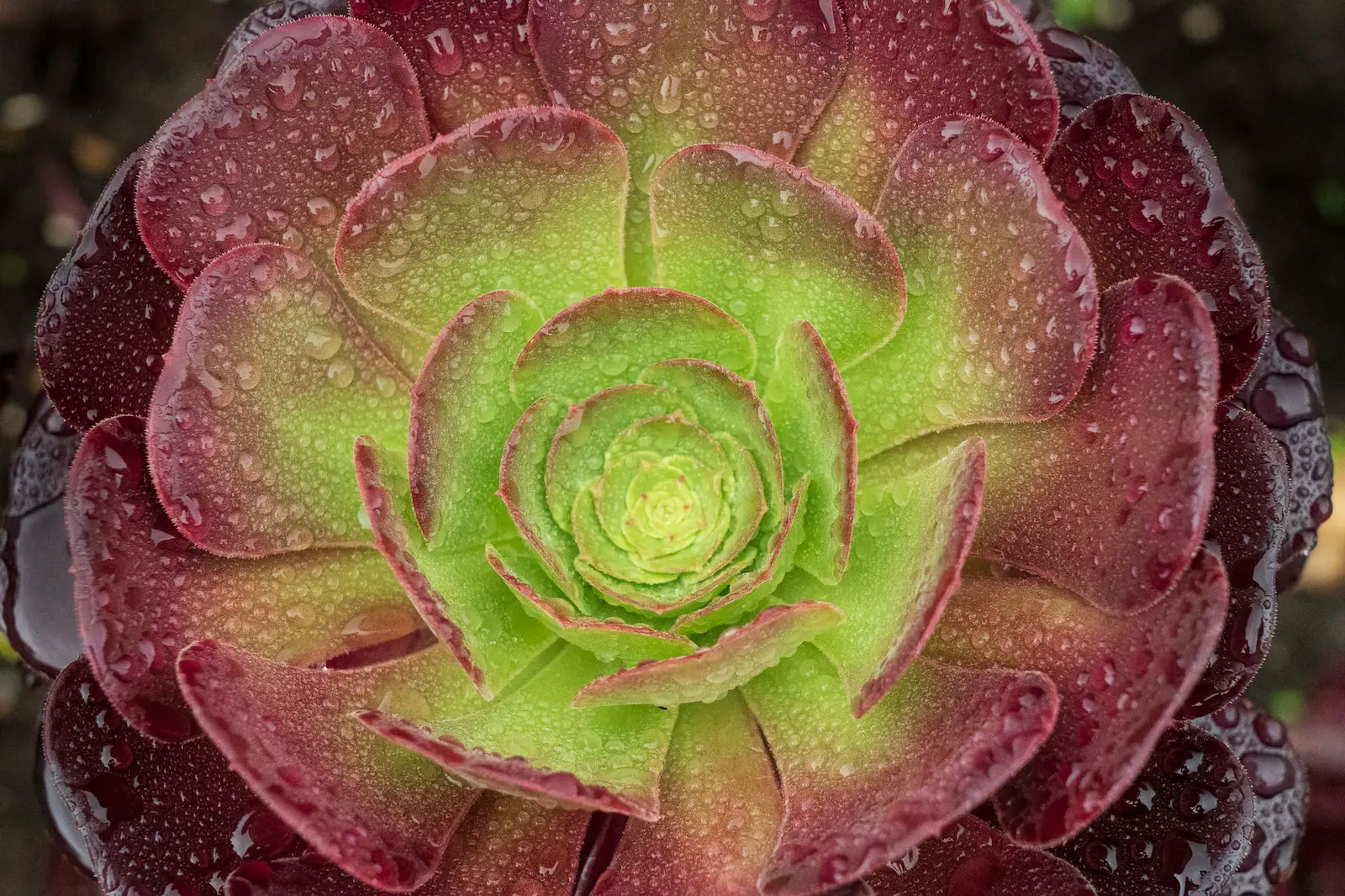Aeonium, a genus of succulent plants belonging to the Crassulaceae family, is native to the Canary Islands, Madeira, Morocco, and parts of East Africa. These rosette-forming plants are known for their fleshy leaves and vibrant colors, which can range from deep greens to purples and reds. Aeoniums are popular in ornamental gardens and as houseplants due to their low-maintenance nature and striking appearance.
With over 35 species and many hybrids, Aeoniums are incredibly versatile, growing both indoors and outdoors. They are often used in rock gardens, containers, or as focal points in landscape design. Their unique appearance and growth habit make them a favorite among succulent enthusiasts and gardeners seeking drought-tolerant plants.
Being a succulent, Aeonium has adapted to thrive in arid environments, storing water in its thick leaves. The varied species within this genus offer a diversity of sizes, shapes, and colors, providing an array of choices for different gardening needs. In addition to their aesthetic appeal, Aeoniums are also known for their ease of care, making them suitable for both beginners and experienced gardeners.
| Attribute | Details |
|---|---|
| Common Names | Aeonium, Tree Houseleek |
| Botanical Name | Aeonium |
| Family | Crassulaceae |
| Plant Type | Succulent |
| Mature Size | 1-3 ft tall |
| Sun Exposure | Full Sun to Partial Shade |
| Soil Type | Well-drained, Sandy Soil |
| Hardiness Zones | 9-11 |
| Native Area | Canary Islands, Madeira, Morocco, East Africa |
Aeonium Care
Aeonium plants, with their unique rosette structure and intriguing coloration, are a valuable addition to any garden or indoor space. Their care is relatively simple, demanding minimal water and well-drained soil. Since they’re succulents, they are able to store water within their leaves, allowing them to survive periods of drought. However, care must be taken not to overwater them, as this can lead to root rot.
When it comes to sunlight, Aeoniums enjoy bright light but can tolerate partial shade. In extremely hot regions, some shade can be beneficial to prevent scorching. Additionally, these plants prefer slightly acidic to neutral soil and can be fertilized sparingly for optimum growth. Regular inspection for pests and diseases and occasional pruning can keep Aeonium plants thriving and aesthetically appealing.
Light Requirement for Aeonium
Aeonium plants prefer full sun to partial shade. They thrive in bright, indirect light, especially when grown indoors. Outdoor Aeoniums can tolerate direct sunlight but may need protection from the harshest midday rays to prevent sunburn.
Soil Requirements for Aeonium
Aeoniums thrive in well-drained, sandy soil that is slightly acidic to neutral in pH. A cactus or succulent potting mix can work well for these plants. Avoid waterlogged or heavy clay soils, as these can lead to root rot.
Water Requirements for Aeonium
Aeonium plants require minimal watering due to their succulent nature. Watering should be done when the soil has dried out completely, usually every two to four weeks, depending on the climate and growing conditions. Overwatering should be avoided, as it can cause root rot.
Temperature and Humidity
Aeonium plants prefer a temperate climate and can be sensitive to frost. They thrive best in temperatures ranging from 60 to 75°F. Humidity levels should be moderate, as excessive humidity can lead to fungal problems.
Fertilizer
A balanced liquid fertilizer designed for cacti and succulents can be applied sparingly to Aeonium plants. Fertilizing once or twice during the growing season (spring to early summer) is usually sufficient.
Pruning Aeonium
Pruning Aeonium plants can help maintain their shape and remove dead or damaged leaves. It can be done as needed, using clean, sharp scissors to trim away unwanted growth.
Propagating Aeonium
Aeoniums can be propagated through stem cuttings. Simply cut a healthy stem and allow it to dry for a day or two before planting in well-draining soil. Rooting usually occurs within a few weeks.
How To Grow Aeonium From Seed
Growing Aeonium from seed is possible but less common. Seeds should be sown in a well-draining mix and kept moist until germination. Patience is required, as growing from seed can be a slow process.
Common Pests & Plant Diseases
Aeoniums can be susceptible to pests like aphids and mealybugs, and diseases such as root rot and powdery mildew. Regular inspection and appropriate treatment can prevent these issues.
Common Problems With Aeonium
Leggy Growth
Leggy growth may occur if the plant is not receiving enough light. Moving the plant to a brighter location can solve this issue.
Overwatering
Overwatering can lead to root rot. Ensuring proper drainage and watering only when the soil is dry can prevent this problem.
Frost Damage
Aeoniums are sensitive to frost, and exposure can cause damage or even kill the plant. Protecting the plant during cold spells or growing it indoors in cooler regions is advisable.
Pro Tips
- Ensure proper drainage to avoid waterlogging.
- Provide bright, indirect light for vibrant color and healthy growth.
- Water sparingly, allowing the soil to dry completely between watering.
- Protect from frost by bringing indoors or using protective covers in winter.
- Use a specific cacti or succulent fertilizer sparingly during the growing season.

